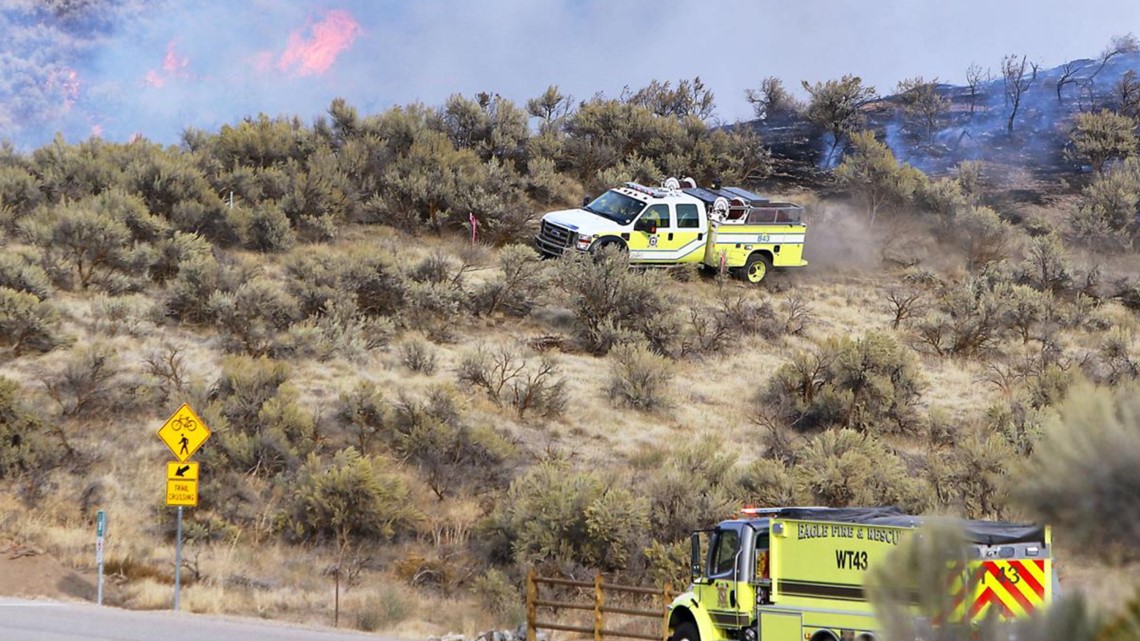BOISE, Idaho —
This story originally appeared in the Idaho Press.
Spring in Boise this year was cool and rainy, leaving the valley greener than normal in the summer.
Though spring rains helped delay the danger somewhat, the wet spring meant more grass grew. And as summer temperatures have risen, that grass is now all dried out and can act as fuel. Now, the area is in an ‘extreme’ fire danger category.
“That shot of moisture that we got, late spring moisture, kind of just delayed us as we move from low to high, to very high, to extreme. It slowed it down a little bit,” said Jared Jablonski, Bureau of Land Management fire mitigation and education specialist.
Right now, the Boise mountains are still in the ‘very high’ fire danger category, but the Snake River Plain, lower foothills and Owyhee Mountains moved into extreme. The ‘extreme’ designation is normal for August, Jablonski said.
The categories are calculated using indicators like fuel moistures and temperatures. The resulting designation is a prediction — if there is a wildfire, how fast will it grow? How extreme will the fire behave?
Essentially, the higher the designation, the higher the flames, the more extreme the behavior and the faster the fire will go.
When fires “behave” in an extreme way, it makes fighting them more difficult. For example, some fires can generate their own weather. Last year, scientists found evidence the Bootleg Fire in Oregon generated its own fire tornado, according to the Associated Press.


The area will likely remain in ‘extreme’ fire danger through the end of August, though it’s all weather dependent. Historically, the fire danger ratings start to move back down beginning in September, Jablonski said.
n southwest Idaho and other parts of the region, precipitation over the last month or so has been around 10% of normal, according to a July 21 National Interagency Fire Center Fuels Briefing.
However, that’s not all bad.
“If the conditions are dry out there, then the potential for fire behavior is going to be extreme… but at the same time without a whole lot of thunderstorms moving through the area, dry lighting isn’t as active,” Jablonski said. “We’ve only had maybe one or two lightning-caused fires this summer, which is below average.”
Three large fires are currently burning in Idaho, according to the National Interagency Fire Center’s website.
One of them, the Moose Fire, burning in the {span}Salmon-Challis National Forest,{/span} has shown extreme fire behavior, according to the fire center’s website. The Moose Fire had grown to 56,000 acres as of Monday morning and was 23% contained.
Humans started the fire, though the exact cause is still under investigation. Some residents from Tower Creek to North Fork are under evacuation orders, according to Lemhi County’s website.
There are ways to avoid starting fires, said Kelsey Brizendine, the fire information officer for the Twin Falls district with the Bureau of Land Management.
- Make sure your trailers are properly attached to your vehicle and trailer chains are not dragging
- Make sure your trailer tires are properly insulated
- Don’t park or drive on tall, dry grass
- Avoid target shooting on hot, dry, windy days
- Don’t use certain types of ammunition, like incendiary or tracing ammunition.
- Don’t use anything made to explode
- Avoid fireworks
- Don’t leave a campfire unattended
“Anything that can prevent that accidental spark, whether it’s the chains hitting the asphalt, the rim of a tire hitting the asphalt … anything like that can cause sparks,” Brizendine said. “One little spark, one little fire can go from nothing to a big problem before you even realize it’s happened.”
Carolyn Komatsoulis covers Boise, Meridian and Ada County. Contact her at 208-465-8107 and follow her on Twitter @CKomatsoulis.
This story originally appeared in the Idaho Press. Read more at IdahoPress.com.
Watch more on wildfires in the West:
See all of our latest coverage in our YouTube playlist:



